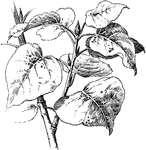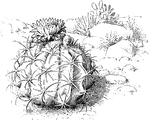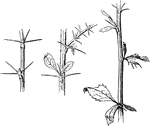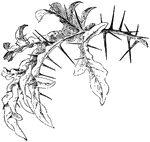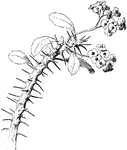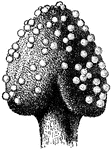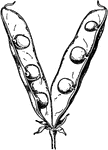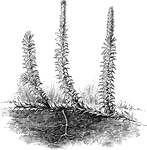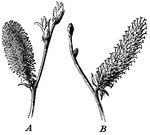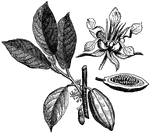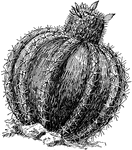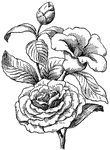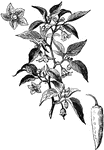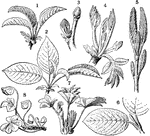
Vernation
"Types of vernation. 1, 2, cherry; 3, 4, European walnut; 5, 6, snowball; 7, lady's mantle; 8, oxalis."…

Pea Leaf
"Pinnately compound leaf of pea. A tendril takes the place of a terminal leaflet." -Bergen, 1896

Compass Plant
"Leaves standing nearly vertical in compass-plant. (Silphium laciniatum). A, view from east or west;…

Common Pitcher Plant
"Common Pitcher-Plant (Sarracenia purpurea). At the right one of the pitcher-like leaves is shown in…
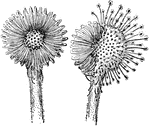
Sundew Leaves
"Leaves of sundew. The one at the left has all its tentacles closed over captured prey; the one at the…

Flower Parts
"The parts of the flower. cal, calyx; cor, corolla; st, stamens; p, pistil." -Bergen, 1896

Stamens and Pistil
"Stamens and pistil of the grape, with a nectar gland, g, between each pair of stamens." -Bergen, 1896
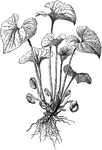
Violet
"A violet with cleistogamous flowers. The objects which look like flower-buds are cleistogamous flowers…
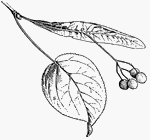
Tilia Fruit
"Fruits of Linden, with a bract joined to the peduncle and forming a wing." -Bergen, 1896
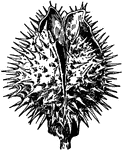
Datura Fruit
"Fruits adapted for dispersal by the shaking action of the wind: jimson weed (Datura)." -Bergen, 1896
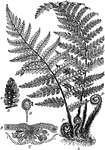
Fern Spore Plant
"Spore-plant of a fern (Aspidium filix-mas). A, part of a rootstock and fronds; fr, young fronds unrollin.…

Scouring Rush
"A scouring-rush (Equisetum sylvaticum). At the right is a colorless fertile stem, in the middle a green…

Spruce Ovule
"Longitudinal section through fertilized ovule of a spruce. p, pollen grains; t, pollen tubes; n neck…

Leaf Bases
"A, Shapes of bases of leaves; B, Peltate leaf of Tropaeolum. 1, heart-shaped; 2, arrow-shaped; 3, halberd-shaped."…

Redcurrant Raceme
"Raceme of common red currant. p, peduncle; p', pedicel; br, bract." -Bergen, 1896

Yarrow
"Head of yarrow. A, top view; B, lengthwise section. re, receptacle; i, involucre; r, ray-flowers; d,…

Fescue Grass
"Fescue-grass (Festuca pratensis). A, spikelet; B, a flower, the lodicules in front and the palea behind;…

Cotton Plant
"Cotton is a downy substance produced on the seeds of he cotton plant, Gossypium, which is herbaceous,…

Flax Plant
"The most common variety of the flax plant has a very slender erect stem, two or three feet high, branching…

Hemp Plant
"Hemp adapts itself to diversities of climate, and is cultivated equally under the burning sun of the…
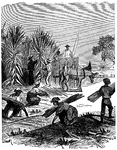
Gathering, Sugar Cane
"The plant tillers like wheat, but not to the same degree. The cane ground is kept clean by hand-hoeing,…

The Castor Oil Plant
"The castor oil plant belongs to an order whose affinities have not yet been accurately limited by botanists;…

Peppermint
"The mint family of plants, of which the most important species are peppermint, spearmint and penny-royal,…

Nutmeg Tree
The nutmeg trees are genus of the evergreen tree. The flowers grown on the nutmeg tree can be used as…
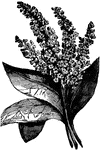
Cinnamon Tree
The cinnamon tree is a evergreen tree small in stature. The bark from the tree is used as a the spice,…

Allspice
"Pimento or Jamaica pepper, otherwise called allspice, is a small berry, the fruit of a beautiful tree,…
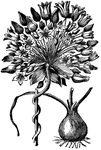
Twining Hyacinth of California
" Our engraving represents a wonderfully singular and beautiful plant, which grows among the mountains…

Banyan Tree
"This tree, a native of India, is remarkable for its vast branches. It is a species of fig; has ovate,…

Prickly Pear Cactus
"Called the Indian fig. The opuntia is a fleshly and succulent plant, destitute of leaves, covered with…

Protococcus Algae
"a genus of algae. P.nivalis (red-snow) appears on the surface of snow, tinging extensive tracts in…
